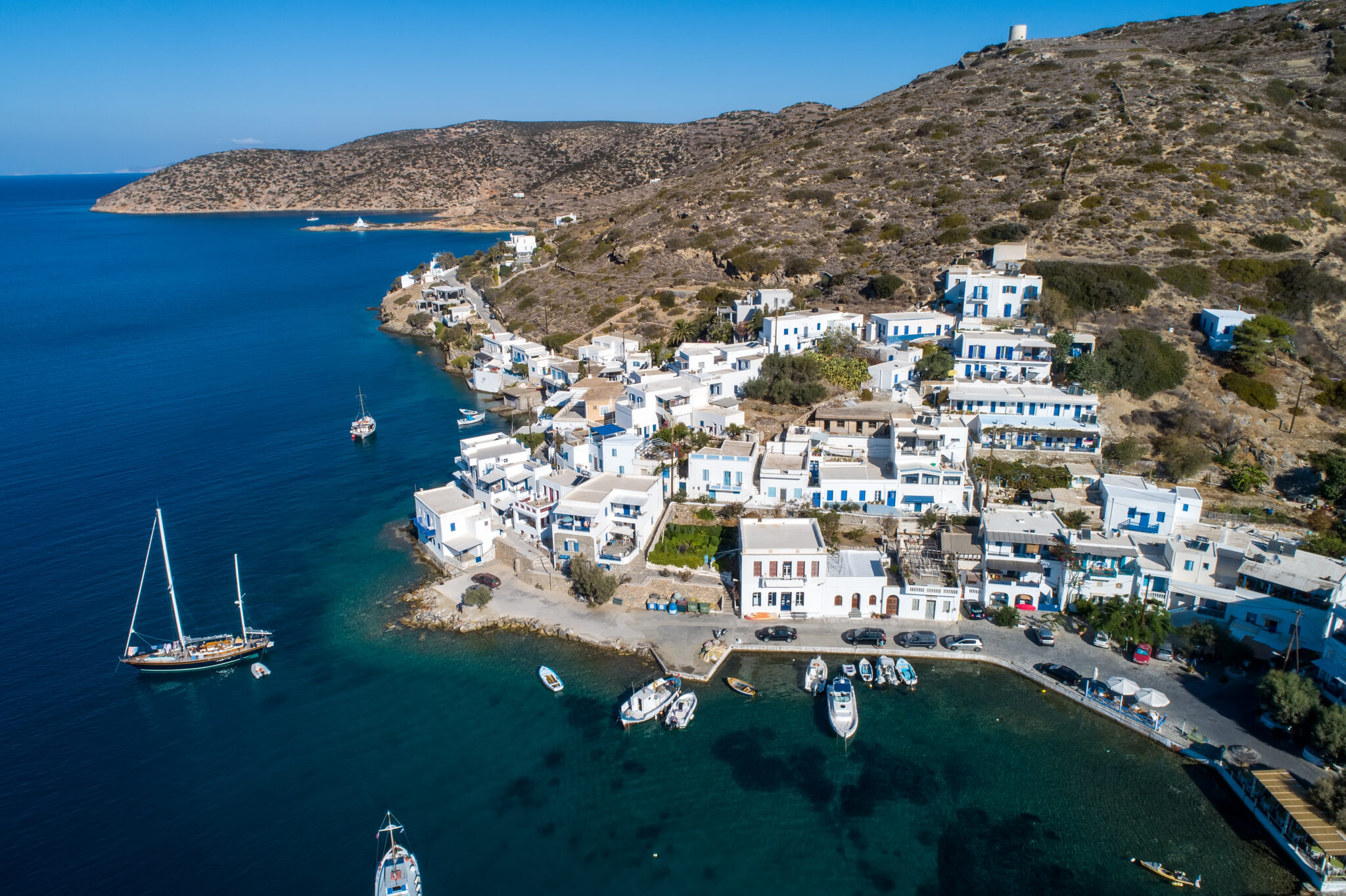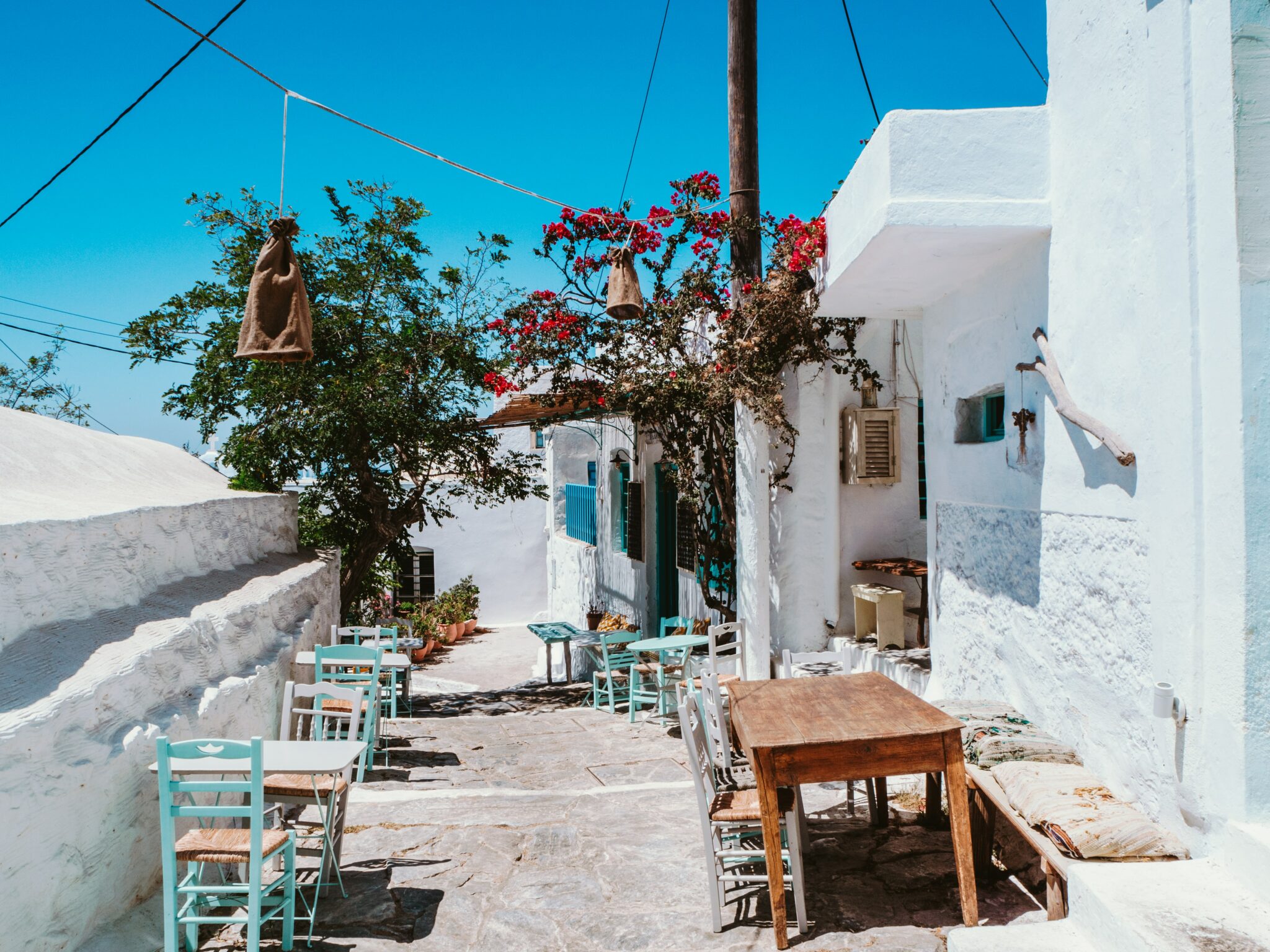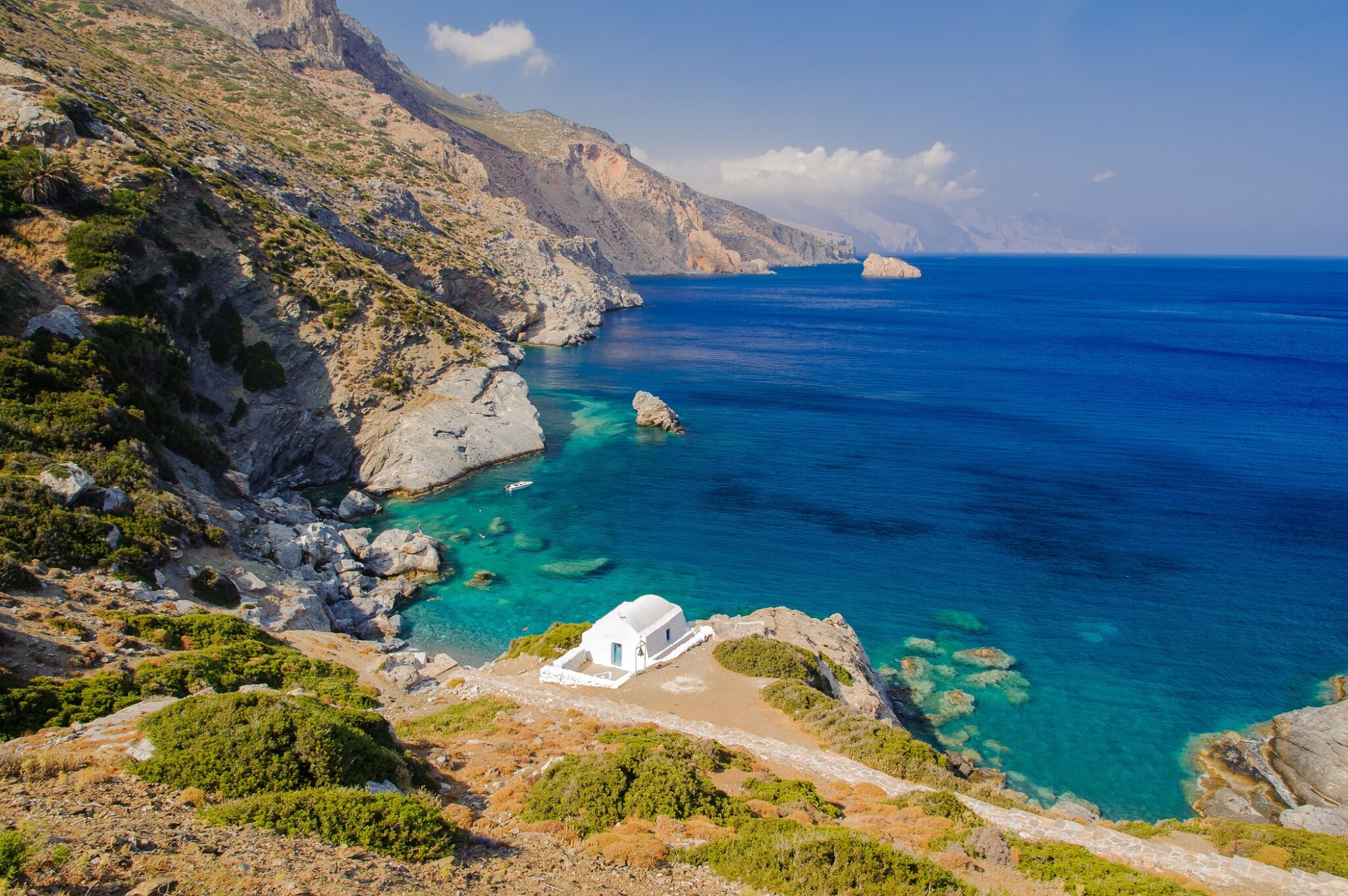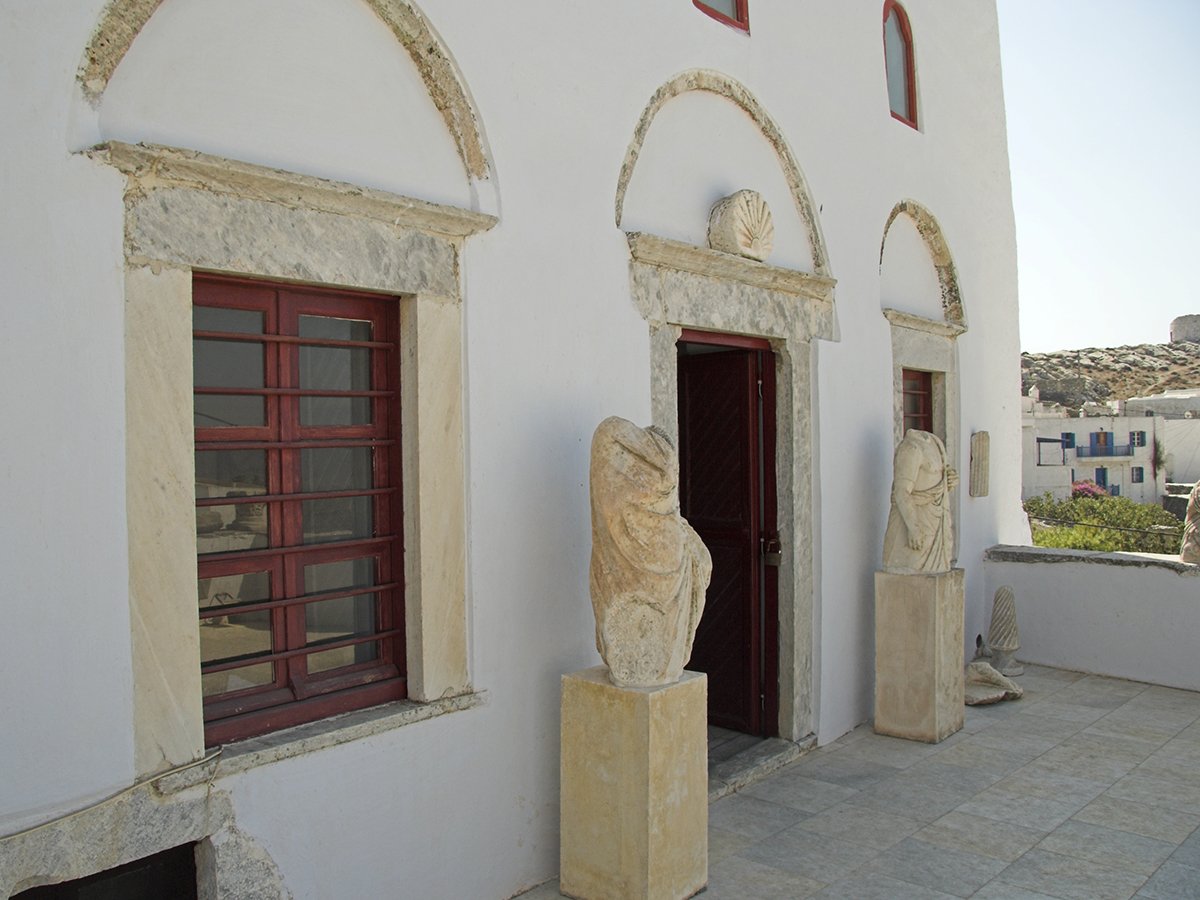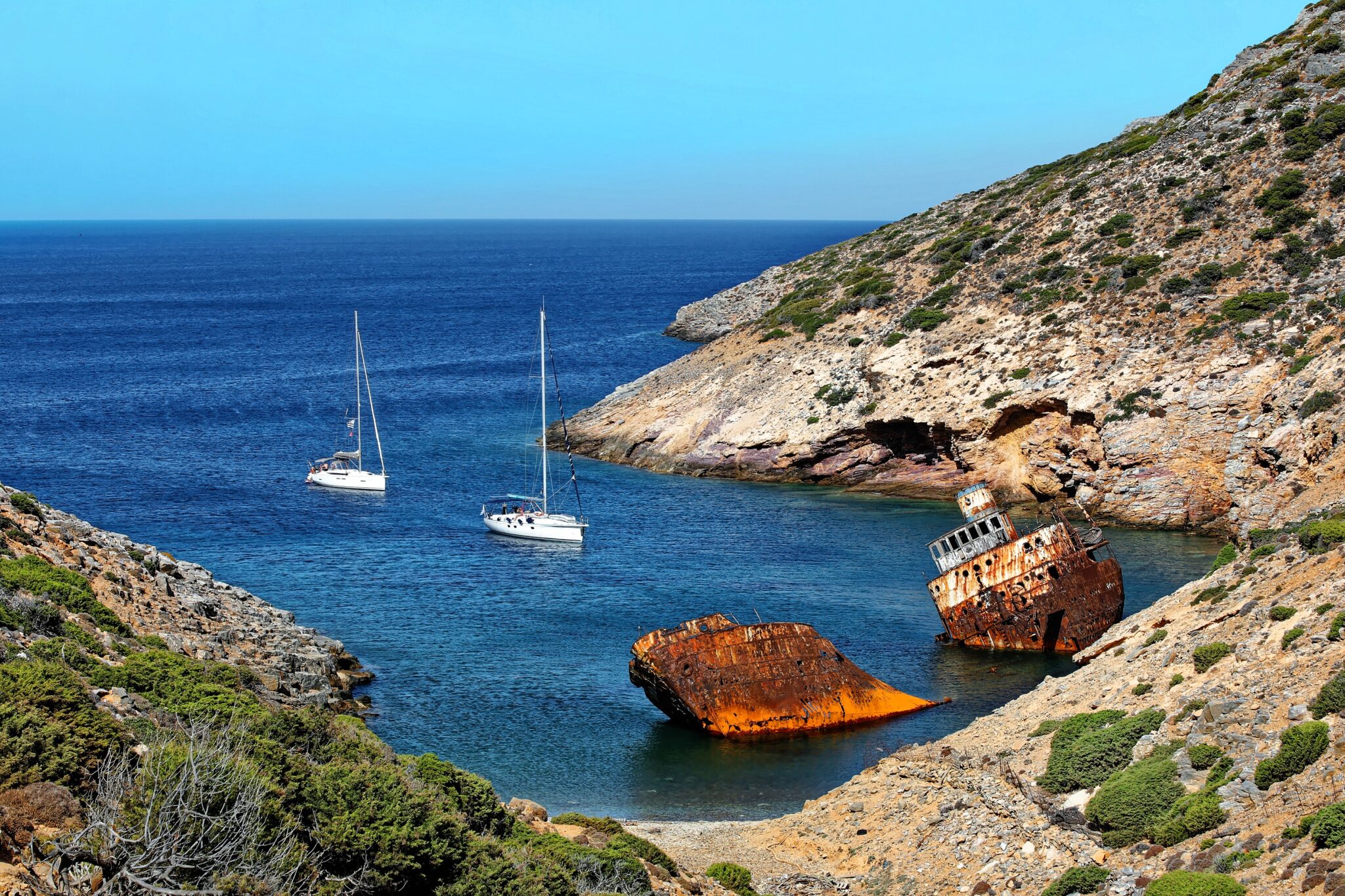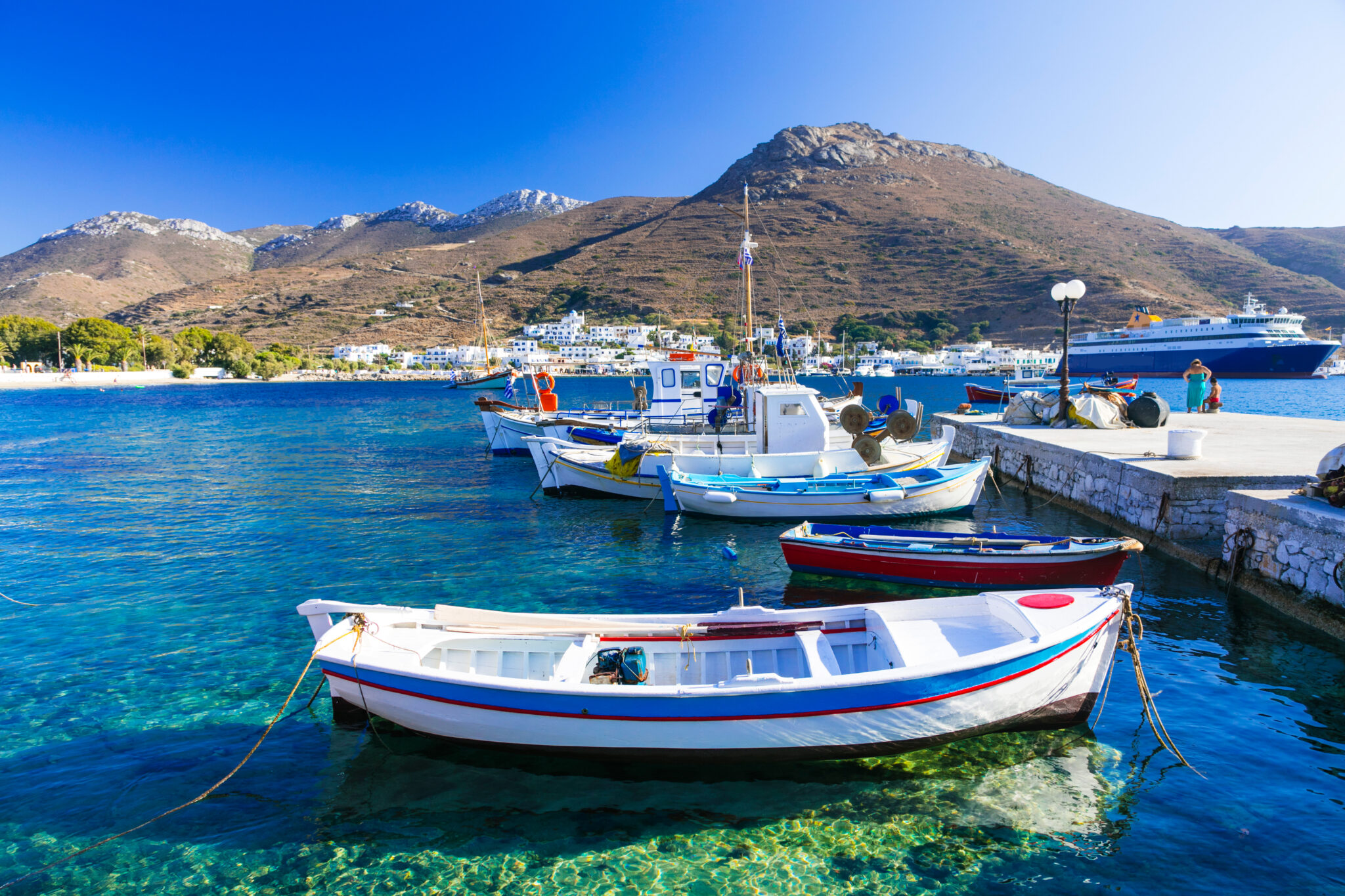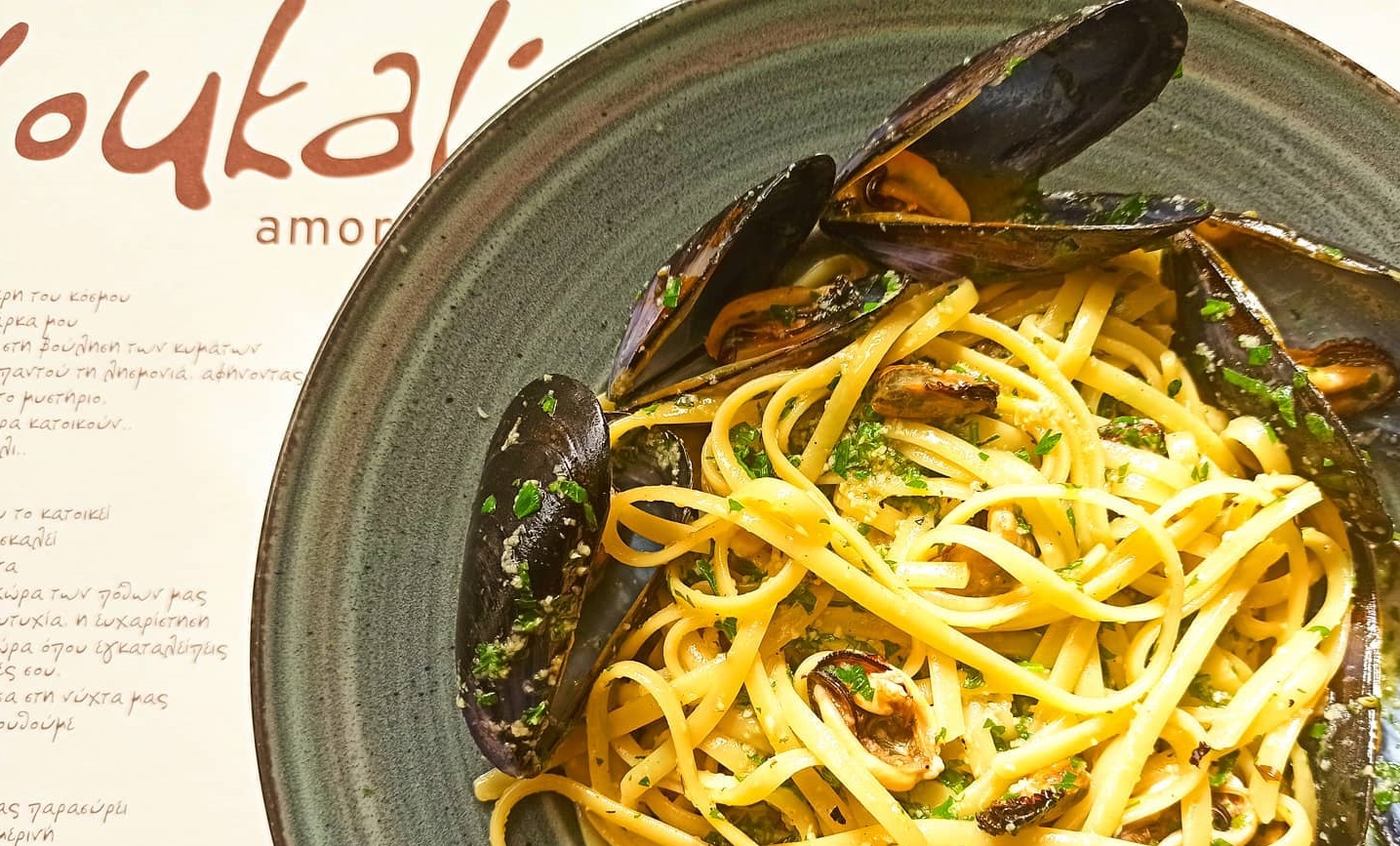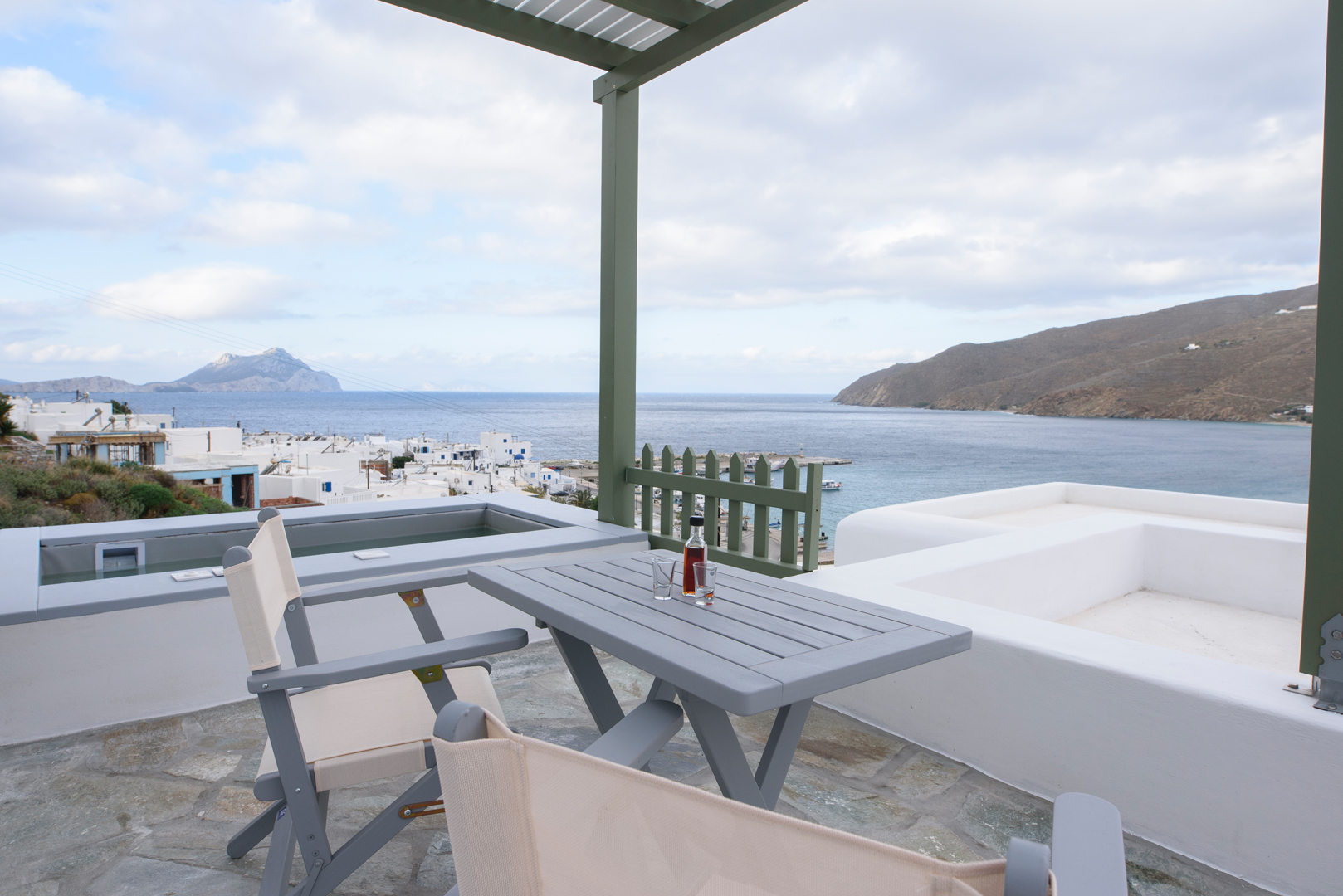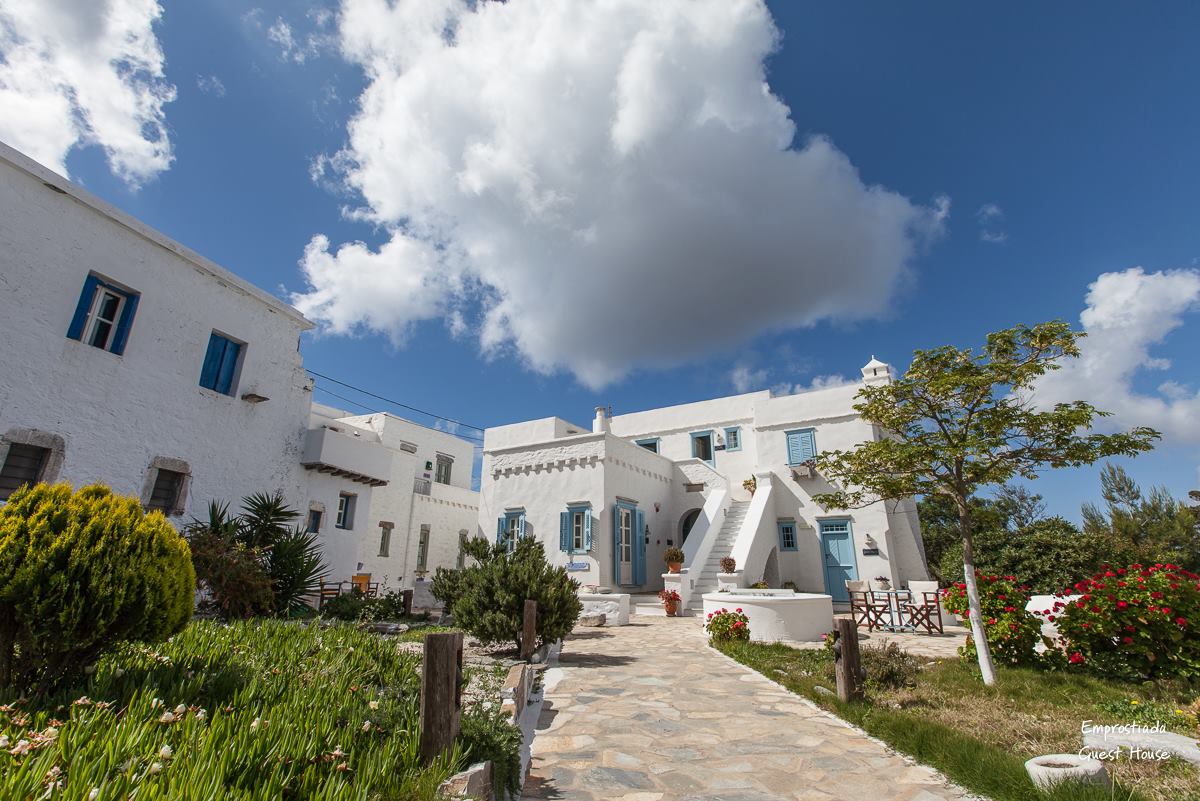A paradise for explorers, divers, and hikers, Amorgos, with its small bays, mountain paths and all-white churches, is the ideal destination for an alternative Cycladic holiday. The island is known for its wild beauty and it shot to fame as the backdrop for the film “The Big Blue”, which was shot on the island over three decades ago, forever changing its future. More recently, the dramatic landscape has inspired other foreign directors and producers to shoot films with international appeal such as the German “Tochter” (2021) and the French “Les Cyclades” (2022).
Although it has gained worldwide fame, in turn attracting many visitors, it remains an unconventional destination perfect for a peaceful holiday. There is nightlife but those who visit Amorgos are not searching for excessive entertainment, preferring to drink their coffee in traditional coffee-shops in the company of the locals, to eat handmade delicacies in the taverns, and to enjoy their cocktails under the starry sky.
If you are planning to visit Amorgos, be prepared to explore; stunning deep waters, sparkling beaches, imposing rockfaces, and meandering paths to be found in every corner of the island. Visit the villages and follow the stone-cobbled streets leading to whitewashed courtyards and picturesque chapels. Climb the steps to the famous churches clinging to cliff edges and admire their hidden beauty and their God-given views.
Explore the medieval castle and breathe in the magnificent bustle of Chora below with travellers and locals in the midst of the small shops, restaurants and bars scattered in its alleyways.
Where to swim
Agia Anna: This is the beach that made Amorgos world famous in 1988, when the celebrated Luc Besson film was shot here, starring Jean Reno. It is just three kilometres from Chora and has particularly crystal-clear turquoise waters which, combined with the rocky coast and the views out to Mikro and Megalo Viokastro islands, create a postcard perfect landscape. The beach is small and gets busy, so if you want to visit, you should go early in the morning or in the late afternoon. Make sure you bring everything you need because there are no services, although there is parking above the beach. Weddings and christenings are often held in the small chapel that gives its name to the beach.
Mouros: One of the most famous beaches of Amorgos, with pebbles and wonderful deep waters. The seabed is ideal for snorkelling with underwater sea caves. It is about 2 km from Kamari and can easily be reached by car from Chora. The impressive, vertical cliffs that frame the small bay provide a stunning background for photoshoots, but offer little respite from the sun. There is a taverna with a car park above the beach with far-reaching views and from there it is a 5-minute downhill path.
Kalotaritissa: A pretty bay sheltered from the wind with the sandiest beach in Amorgos, Kalotaritissa is easily accessed by car, following the road to Arkesini. It has umbrellas, sunbeds, a beach bar, and tourist boats depart from here for the magical island of Gramvoussa. Make a detour on the way to the beach to visit the eerie shipwreck of the ‘Olympia’ in a nearby cove.
Levrossos: A sandy beach, about 20 minutes walk from Aegiali, it is one of the better beaches in the area. It used to be predominantly nudist, but nowadays it is popular with families with young children as the water deepens gradually and there is shade from trees. You can visit by boat, bus, or car, but parking spaces are limited. The path, starting at the parking area, is downhill and includes several steps, so it is not suitable for people with limited mobility. The beach is not serviced, but there is a taverna where you can eat, and you can also walk further to the smaller beaches of Psiliammos and Choklakas.
Maltezi: This beach is located northwest of Katapola and is considered one of the most beautiful in the surroundings. It is serviced, sheltered, with fine sand and turquoise waters. Access to Maltezi is by boat from the port of Katapola or by walking for about 20 minutes and following the path from the tiny village of Xilokeratidi.
Agios Pavlos: This is a shore with a distinctive shape; a curved finger of land entering the water. The beach is covered in large white pebbles and it has clear waters. It is serviced, with a beach bar, sunbeds, and umbrellas, while tourist boats depart here for the island of Nikouria.
Nikouria: You can swim on the shores of this small uninhabited island located across from the beach of Agios Pavlos. The islet has 3 beaches, all with sand and stones, and a curious population of goats and sheep.
Gramvoussa: From the bay of Kalotaritissa, you can take a tourist boat and visit the island of Gramvoussa, a short ride nearby. With golden sand, clear waters and a view back across to Amorgos, it is popular with speedboats and ribs that approach the islet during the summer months. On the beach, you will find sunbeds and umbrellas, however there are no other facilities, so make sure you have the necessary supplies. Impressively, considering its remoteness and harsh terrain, Gramvoussa was inhabited until the 1990s when the last family left.
What to do
Panagia Hozoviotissa: The second oldest monastery in the Greece, it is an icon of the Cyclades, built so that it looks like it is clutching on to the edge of the cliff. Visible only from the sea, to reach its entrance you must climb 350 steps but the view from the top will reward you. After passing through the narrow door, you climb another 8 floors so that you can admire the Catholicon with its Byzantine icons of Hozoviotissa.
Agia Triada: The chapel of Agia Triada is located in Lagada and is of great interest because of its architectural peculiarity; it is built in a cave, high up on a steep cliff. To reach it, climb a narrow stone staircase with 65 steps. It was built during the years of pirate raids and the inhabitants occasionally used it as a hiding place. It is wedged into the rock and offers a spectacular view of the bay of Aegiali.
Archaeological Museum of Amorgos: Located in Chora and housed in the Tower of Gavras, a historical monument built during the Venetian rule. The main exhibits are sculptures, statues and reliefs dating from the Archaic period (6th century BC) to the Roman Empire (2nd century AD) mainly from the three ancient cities of Amorgos; Aegiali, Arkesini and Minoa. (tel. 2285 071831)
Folklore Museum of Amorgos: The museum is housed in a historic house in Chora, which has been preserved unchanged and offers visitors the opportunity to admire objects of everyday household use like pitchers and pots, agricultural and livestock tools, such as the shovel, the plough, the millstone, containers for collecting, transporting and storing fruit, and samples of basketry and photographic material showing the harsh conditions of everyday life in the past, at home, in the field or in the pasture and how they managed to tame the wild nature of the island. In addition, you will see the interior furnishings and decoration of a traditional Amorgos house.
Archaeological interest: In various locations around the island, you can see remnants of ancient civilizations, which prove that Amorgos has been inhabited since Prehistoric times. The point of greatest interest is the hill of ancient Minoa and the present-day site of Katapola, where a vaulted Mycenaean tomb and temple of Apollo have been discovered.
Venetian Castle: The Venetian castle was built in the 13th century by Venetian rulers to protect the island from the Saracen pirates. It is 65m high, imposing its presence on Chora. Around the castle lies a traditional settlement with white Cycladic houses and winding narrow streets.
Windmills of Amorgos: Across from the Venetian castle stand the traditional windmills that survive until today. For more than 300 years, dozens of windmills scattered all over the island supplied the locals with precious flour. Today, only eleven remain, adding their special aura to the idyllic setting of Chora.
The ‘Olympia’ Shipwreck: Located in Kato Meria, near the beach of Kalotaritissa, the ‘Olympia’ shipwreck is half-sunk, just a few meters from the coast, and is one of the most popular and impressive sights on the island. The ship was built in 1950 and wrecked in 1980, when, during a violent sea storm, it unsuccessfully tried to find shelter in the bay.
Trails: There are many trails on the island, some of them ancient, others more recent. Most of them are in excellent condition because they are still used today by the locals who keep farms and cattle in dispersed parts of the island. There are 12 marked hiking trails, and you will find them on the map published by the Region of South Aegean, but in some places the signposting has suffered damage and elsewhere it has even been lost and you need to be careful. The network includes routes for all levels of difficulty. In addition to the trails, the map accurately shows the beaches and all the sights. You can buy it in the shops on the island or at www.terrainmaps.gr. You can also get it in electronic form on your mobile phone from the Avenza Maps website.
Culinary identity
Mountainous and barren, the island of Amorgos is home to thousands of sheep and goats grazing freely on the rocks in the mountains or by the sea. Meat is at the core of the island’s cuisine with typical dishes such as “Patatato” (goat or lamb with spiced potatoes and red sauce), “Aranista” (stuffed goat with
rice soup), and “Xidato” (tripe soup seasoned with vinegar). The long tradition of livestock farming provides plenty of milk and many special goat and sheep cheeses, mainly home-produced: hard and salty Melipasto, Graviera, Myzithra, Xinomyzithra, and small quantities of Kopanisti.
The fava of Amorgos comes from the plant Katsouni, like the fava of Schinoussa, and differs from the Plantlathouri, which is the fava of Santorini. It is served as “Fava Pantremeni” (fava beans boiled with onion, capers, oil, and lemon) and also as “Favokeftedes”, fritters made by mixing boiled fava beans with fennel and chopped onion.
The island’s green pies are traditionally made with wild chards and herbs. The abundance of these aromatic herbs creates ideal conditions for the development of beekeeping. Thyme honey is the main product, but flower honey is also produced. The local olive groves, mainly around Aegiali, planted with the varieties “Manaki Koroneiki” and “Hontrolia”, produce good quantities of extra virgin olive oil.
The island also has small fleet of fishing boats that contribute to the local gastronomic character. Sun-dried Blotched Picarels are an island speciality; the fish are first salted and then dried in the sun, and served as a snack for ouzo.
In the lowlands, quantities of wheat and barley were traditionally grown, and several families still use wheat rye to make their own black yeast bread and “Pavlus”, a type of rusk. Traditional sweets include the “Xerotigana”, made with a thin dough shaped as a rose and covered in honey and sesame seeds, and the Sesame Pasteli (honey and sesame bar). As for drinks, “Roasted Raki”, a kind of liqueur based on Raki and honey and flavoured with herbs and spices, is famous. Even before it became known throughout the country, it was a concoction drunk hot to relieve colds and coughs. Similarly, women drank it on visits and at festivals to avoid the strong Raki that men drank. Today it is produced at a winery-distillery on the island under the name “Rakomelo” and it is served throughout Greece and exported to foreign countries.
Where to eat
Yorgalinis: Family tavern within a beautiful garden, it is known for its grilled meat and its generous portions. The meat is all sourced from their own farm. (Vroutsi, Amorgos, tel.: 0030 2285 074290)
Yukali: Restaurant with Mediterranean cuisine and seafood, meat, and vegetarian options. Its dishes include orzo with beetroot, roasted goat, linguini with fresh mussels, and shrimp pasta. (Xilokeratidi, Katapola, Amorgos, tel.: 0030 2285 071838)
Transistoraki: A beautifully decorated room in the busiest alley in Chora stumbles out onto the street. Delicious Greek delicacies and carefully selected ingredients are cooked with creativity. (Chora, Amorgos, tel.: 0030 698 882 0049)
To Limani tis Kira Katinas: One of Amorgos’ oldest taverns serving fresh fish and traditional Amorgian dishes such as Patatato (goat braised with potatoes) and Octopus pie is located on a blooming alleyway. The celebrated Lobster pasta is a must try. (Amorgos, Aegiali, 2285 073269)
Where to stay
Aqua Petra:, This apartment complex with a swimming pool, a restaurant, a bar and views of the island of
Nikouria, is located next to the beach of Agios Pavlos. (Agios Pavlos, Amorgos tel.: 0030 285073011)
Theasis Suites: These newly built suites are located in Aegiali, near the beach, overlooking the bay. Each has a private pool and exclusive amenities, and they combine modern and traditional style. (Aegiali, Amorgos, tel.: 0030 6981 155 755)
Emprostiada: A traditional stone guesthouse at the northern entrance of Chora, it has rooms, suites and maisonettes available. (Hora, Amorgos, tel.: 0030 693 224 8867)
Porto Katapola: Pension right at the port of Katapola, with a sea view. It has fully renovated rooms and apartments and is just 5m from the sea. (Katapola, Amorgos tel.: 0030 697 894 8458)
Read also:
Amorgos: Experiences on the island of “The Big Blue”
Amorgos: The island of endless blue is on a roll
Sailing at the Small Cyclades -Aegean’s most impressive waters, sea caves, secluded bays



